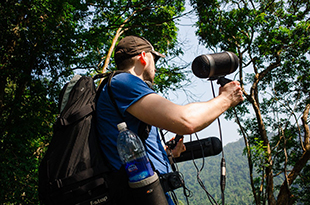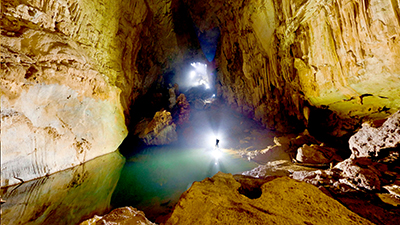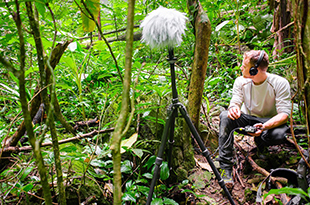![]() Called the Infinite Cave because of its size, Son Doong is among the world’s biggest caves. Recently, photo journalist Martin Edström led a team that photographed it and recorded the sounds occurring inside it.
Called the Infinite Cave because of its size, Son Doong is among the world’s biggest caves. Recently, photo journalist Martin Edström led a team that photographed it and recorded the sounds occurring inside it.
‘Sound wide, there was always something to be heard – wind, water dripping, a river running, distant birds and sometimes also the thundering silence, if you know what I mean.’
 Discovered in 1991 inside Vietnam’s Phong Nha-Ke Bang national park, the entrance to the cave was instantly ‘lost’ until 2009, when its local discoverer relocated it and explored it with a group of British scientists.
Discovered in 1991 inside Vietnam’s Phong Nha-Ke Bang national park, the entrance to the cave was instantly ‘lost’ until 2009, when its local discoverer relocated it and explored it with a group of British scientists.
The 5km-long cave is comprised of chambers up to 180m high. They are filled with stalagmites and phytokarst (a distinctive landform resulting from biological erosion) as well as vegetation at the points where the cave’s ceiling has collapsed. A fast-flowing river also passes through.
Edström heard about the cave in 2014 and began to research them. News that the caves were being considered for possible exploitation for tourism, he acted to document their almost untouched beauty it in a 360° story and make a photo archive for National Geographic. ‘I hope that our documentation of Son Doong will not only help tell the story about this cave, but also preserve a kind of digital copy of the cave – making sure we can visit it digitally whatever happens to it in the future,’ he says.
He moved quickly – on securing National Geographic and a group of sponsors to support an expedition to Son Doong, he established a team of six and quickly started planning their trip. ‘We had just little more than two months to arrange for everything.’ He recalls. ‘The logistical effort was enormous. To give you an idea, we had 300-400kg of technical gear to take to Vietnam and drag around with us, cameras, lots of lighting, tripods, you name it. This is excluding tents and food and the like. We had fantastic help from an expedition team in Vietnam to arrange these everyday expedition logistics.’
Key to the sound recording were Sennheiser stereo and shotgun microphones.

As well as being assistant photographers, Erik Hinnerdal and Mats Kahlström were to capture the sound. The mics selected by Edström and his team included an SPM 8000 stereo microphone, an MKH 8060 short gun microphone and an MKH 8070 long gun microphone. All three are based on Sennheiser’s MKH 8000 series of radio frequency condenser microphones, which deliver natural sound with extremely low self-noise and high resistance to hostile climatic conditions, such as moisture, damp, cold and heat.
Edström and his team spent two weeks in Vietnam and about a week inside the cave. Meanwhile, the original team had been expanded by guides and porters and counted about 50 people. ‘We spent five very concentrated days in the cave photographing and recording. The biggest portion of this time was taken up by lighting the cave properly, as Son Doong is so enormously big. Sound wise, there was always something to be heard…
‘The SPM 8000 stereo microphone was always on recording duty, it was great for capturing the atmospheric audio,’ Edström says. ‘We used the MKH 8060 short shotgun microphone about 50 per cent of the time, when we wanted to highlight a sound, for example the singing of birds, or some sounds of the river that flows through Son Doong.’
 The MKH 8060 was also the microphone of choice for recording the Vietnamese song that can be heard when the virtual expedition in the National Geographic story reaches the second doline (a shallow depression of the ground surface). ‘The song is actually sung by one of the guides,’ Edström says. ‘He has such a great singing voice. The song was written by a famous Vietnamese composer and is about unity in Vietnam. We thought this would make a great addition to the material. You can hear the song from afar when you get to the second sinkhole, it becomes louder when you continue through the jungle, and fades away when you enter the cave again.
The MKH 8060 was also the microphone of choice for recording the Vietnamese song that can be heard when the virtual expedition in the National Geographic story reaches the second doline (a shallow depression of the ground surface). ‘The song is actually sung by one of the guides,’ Edström says. ‘He has such a great singing voice. The song was written by a famous Vietnamese composer and is about unity in Vietnam. We thought this would make a great addition to the material. You can hear the song from afar when you get to the second sinkhole, it becomes louder when you continue through the jungle, and fades away when you enter the cave again.
‘The MKH 8070 was used for about 25 per cent of the recordings to capture far-away sounds – which happened quite a few times in this gigantic cave,’ he continues. ‘It was used to record water dripping, far-away birds, and also to raise some of these sounds above the rushing river.
National Geographic: Dive into Infinity